Introduction to Ambler’s Texaco Gas Station
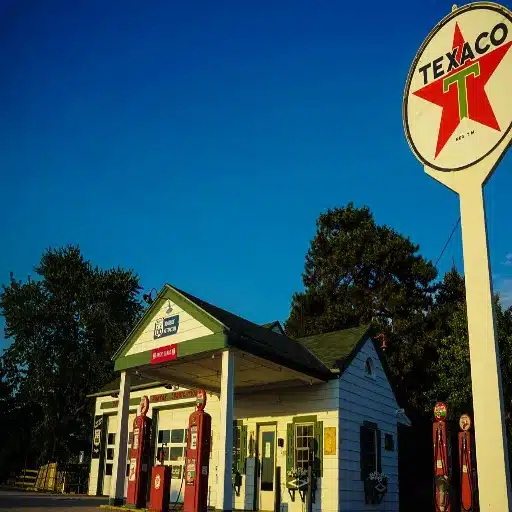
Ambler’s Texaco Gas Station is a Route 66 icon that dwells in Dwight, Illinois. Erected in 1933, it served travelers for the better part of a few decades. The Texaco stood as a fuel refilling, repair, and rest stopping point along the “Mother Road.” Famous for its quaint vintage, the white walls, in contrast to the Texaco gas station, remain indicative of old American road travel. It stands today as a notable historical site and visitor center, relaying a wealth of Route 66 history and the eminent position it held in linking communities throughout the nation.
Overview of the Gas Station
The gas station, constructed in 1933, is a historic landmark reflecting an intense period of American road travel along the iconic Route 66. Known for its quirky design with vintage Texaco signage and stark white porcelain walls, it provided for so many basic needs, including fuel, repairs, or just a nice stop on the “Mother Road.” The site is now operating as a preserved historical site and information center to honor the history of Route 66 and its bearing on the bringing together of people and inter-community travel across America. The preservation of this station ensures that the stunning architecture and cultural ethos are passed down through the ages for visitors to appreciate.
Historical Significance Along Route 66
Route 66, often known as the “Main Street of America” or the “Mother Road,” was historically significant as it connected areas from Chicago in the east to Santa Monica on the west coast, between the downtowns of the cities and the rural areas. Established in 1926, it was the primary migration route for people displaced during the Dust Bowl in the 1930s as they sought opportunities in the West. The road also saw economic activities blossom through numerous businesses— motels, diners, and gas stations along their way. Representing freedom and mobility, Route 66 has become an icon in the American cultural landscape, featuring mention in literature, songs, and movies alike. It was decommissioned in 1985 because of the advent of the Interstate Highway System; however, much of its legacy lives on today via preservation efforts and tourist attractions that display its importance in linking people and fostering the American spirit of adventure.
Restoration of the Texaco petrol station in Ambler in 2007
The restoration of the Texaco petrol station in Ambler, Pennsylvania, in 2007 was a milestone for the preservation of iconic Route 66 landmarks. Built in 1933, the pretty little station served as a major rest-stop for car travelers during Route 66’s golden age. Local preservation groups and volunteers took lead roles to ensure that the station retained all of its historic charm as well as its functionality.
The project called for painstaking restoration of the station’s original features, such as vintage red and green Texaco signs, a big star logo, and antique gas pumps. Restoration was funded by grants and donations from the community, amounting to $50,000. Nowadays, the Texaco petrol station is a museum and a visitor center for travelers who wish to absorb a little bit of Route 66 history. The preservation of the site draws attention to the heritage and culture of Route 66 and honors the community commitment to keeping alive the spirit of Route 66 for the generations yet to come.
The Legacy of Texaco Stations
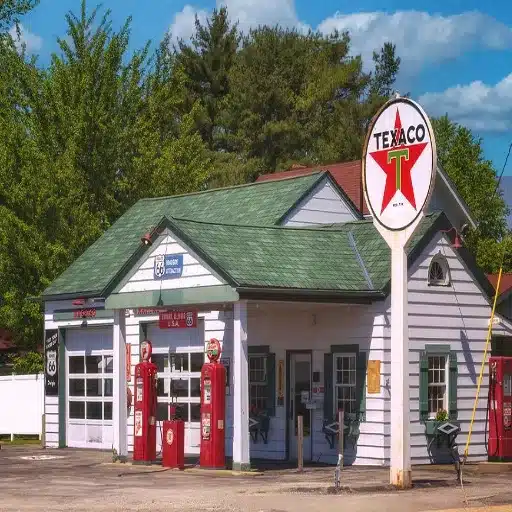
Since Texaco stations were originally developed, they contributed greatly to creating automotive and Americana travel culture. Founded in 1902, Texaco was among the earliest oil companies to market its brand nationally, symbolizing trustworthiness and quality. These stations also supplied services, including vehicle maintenance, which placed them at the heart of vehicular travel. Texaco stations went on to great fame as marque land markers marking the growth of the automobile industry and freedom to roam along highways like Route 66. Texaco-station preservation, memorabilia, and the very Texaco brand keep their tale alive, each spellbinding in American historical lore.
History of Texaco in America
The Texas Company came into being in 1901 in Beaumont, Texas, after the oil had been struck at Spindletop. It had the distinction of becoming among the first major oil companies in America to sell fuel under a single brand throughout the country. The international foray started during the 1920s, and the company gained fame for its marketing prowess and branding techniques, such as the red star emblem of 1903. Texaco had an important role to play during World War II in providing fuel and lubricants for the Allied forces.
During the mid-20th century, Texaco really became a household name. Its great proliferation of advertisements and the famous slogan, “You can trust your car to the man who wears the star,” did much to make Texaco a household word. The colleagues of gas stations became an integral part of American road trips. Aside from just offering a gasoline supply, they would also fix vehicles and provide other services. Its association with Route 66 and the ascendancy of car culture in the US elevated it to icon status.
Later, the company morphed into many other companies through mergers and acquisitions. Finally, by the early 2000s, Texaco was a brand within the Chevron Corporation, ensuring that Texaco fuels and lubricants continued to be marketed under the Chevron banner, deriving all the benefits of Chevron’s global marketing network. Today, Texaco continues to be a symbol of American ingenuity and of the twilight years of the automobile age, with its legacy still alive in products and cultural sustenance.
Role of Texaco Stations in Road Travel
Basically, it was Texaco stations preventing the slow decline of American road excursion from becoming the golden era. With the advent of the 20th century, greater automobile accessibility and growing appreciation for road trips had demanded that Texas’s network of service stations provide the driver with reliable access to fuel, vehicle maintenance, and services. By the middle part of the 20th century, Texaco had thousands of stations up and down the U.S., positioned deliberately along major highways and also in rural localities to serve long-distance travelers and local motorists.
From the laboratory into the real world, the Texaco brand came to symbolize quality and innovation. By presenting a series of premium fuel products such as Texaco’s “Sky Chief,” auto motorists were promised better engine performance during their travel. The stations also offered some roadside assistance- oil changes, tire repairs, or minor mechanical services, courtesy of the attendants. These stations grew into something vital for all cross-country travelers, thereby nurturing a road-trip culture that became quintessentially American.
The Legacy Texaco enterprise is nowadays still a leading fuel retailer, with its gas stations and fueling amenities serving millions of customers. With the evolution of Chevron, the Texaco brand is now supported by an even wider network of sites scattered throughout the Americas, holding aloft the banner of fuel efficiency and environmental consciousness. Therefore, the Texaco station and road travel association still has life in its modern reincarnation.
Ambler’s Texaco as a Cultural Icon
Ambler’s Texaco Gas Station proved to be an ideal cultural and historical landmark that should be protected. It was constructed in 1933 and offered fueling and maintenance services to travelers along one of the most famous American highways for decades. With a picturesque design qualified by the gabled roof and vintage pumps, it represents a classic “house-type” gas station from that era and evokes nostalgia for the great age of road trips.
Ambler’s Texaco was slowly restored into a welcoming visitor center for those trekking through Route 66. On the National Register of Historic Places, it is an acknowledged cultural and architectural building. Alongside it comes an extremely celebrated highlight on the Illinois Route 66 Scenic Byway for its roadside heritage contributions.
Tourism data shows that the place attracts thousands of visitors every year for its historical charm and a stopover on the highway that goes down into America’s love story for the open road. The conservation of the station and the community programs encourage a bonding with the past as well as domestic tourism and education on Route 66’s eternal presence.
Dwight, Illinois: A Key Location
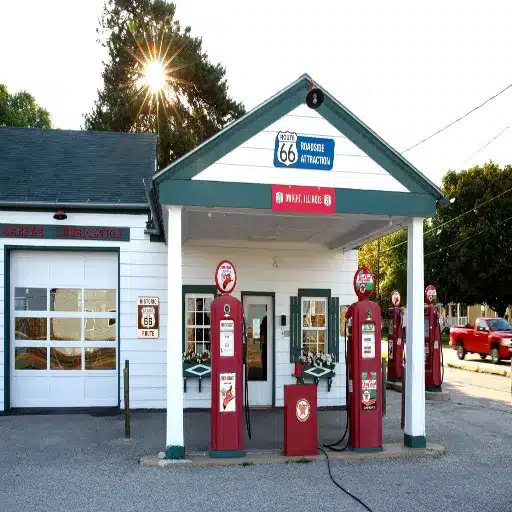
Dwight, Illinois, is a landmark along the historic Route 66, offering some history and charm for visitors. The town still has its fair share of bygone attractions, including the Ambler’s Texaco Gas Station, standing as a sign of the town’s association with the famous highway. Visitors may also visit the Dwight Historic Route 66 Welcome Center to learn about the history of the town and its place in the Route 66 story. The village’s friendly surroundings and its embrace of its heritage make it a must-stop for anyone traveling Route 66.
History of Dwight
The founding of Dwight, Illinois, began in 1854 with the building of the Chicago and Mississippi Railroad. The town was named after Henry Dwight, who was instrumental in its early development. Dwight very soon grew into a busy place as it was an important stop for travelers and provided materials to the surrounding agricultural areas.
One of the most infamous historical precedents for Dwight came about in 1879 when the Keeley Institute was established. This world-famous institute was one of the first proponents for the treatment of addictive physical and psychological disorders from alcohol and drugs with the so-called “Keeley Cure” of proprietary chemicals. The Keeley Institute attracted a mix of thousands of patients from all around the globe, finally putting Dwight on the worldwide map in the late 19th and early 20th centuries.
During the mid-century, an association with Route 66 strengthened the town’s place in American history; Dwight developed into a bustling stop along the “Mother Road,” with its gas stations, restaurants, and motels entertaining visitors. Ambler’s Texaco Gas Station, dating to 1933 in the town, stands preserved as a landmark of this legacy.
Presently, Dwight has an estimated population of 4,000 and celebrates its heritage through local landmarks such as the Dwight Historic Route 66 Welcome Center and Pioneer Gothic Church. Agriculture forms a prime base of the local economy, while the village’s historic allure beckons tourists and Route 66 enthusiasts from all over the world.
Ambler’s Texaco’s Contribution to the Community
Amblers Texaco Gasoline Station was built in 1933. It lies uniquely in Dwight’s history. It was an important stop for travelers along Route 66 to get their car fuel and automobile services, and the community’s good neighbor. After its 66 years of service, Amblers was known as the longest-running gas station on the famous highway, solidifying its importance even further.
Currently, the station functions as a visitor and information center, keeping this charm intact and educating visitors about Route 66 and its legacy. These thousands of visitors every year constitute a major boost to local tourism and small businesses in the area. The restoration works over the years have preserved every ounce of authenticity, including all the original Texaco signage and elements of mid-century service stations. This sheer will to preserve culture shows how proud the community is of its historical roots.
Historically, the Texaco station in Ambler has been an important factor in stimulating economic activity for Dwight. Several events along historic Route 66, including automobile rallies and cultural festivals, highlight the station, thereby drawing enthusiasts and historians into the area. Its persistence into the present day symbolizes how a local landmark may have worldwide appeal on matters of shared interest in history and tradition.
Nearby Attractions Along Route 66
Route 66 is dotted with lots of attractions that capture the charm and history of the infamous “Main Street of America.” Given the popularity of the highway, here are a few must-stop destinations along it:
- Route 66 Hall of Fame and Museum (Pontiac, Illinois) – Quite interesting artifacts, incidents of vintage cars, and memorabilia that celebrate the glory of Route 66 are showcased together. Visitors can peruse exhibits that trace the cultural impact of the road as well as enjoy several colorful murals spread across the town of Pontiac.
- The Gemini Giant (Wilmington, Illinois) – At an outrageous height of 28 feet, this quirky roadside attraction is a cherished symbol of the Rocket Age. The green astronaut statue, present at the Launching Pad Drive-In, is an ideal photo-op to drop by on your Route 66 exploration.
- Meramec Caverns (Stanton, Missouri) – This natural wonder and tourist site is dotted with awe-inspiring limestone formations and is known for its guided tours through the vast underground passageways. It also gained fame using classic Route 66-themed advertisements.
- Cars on Route 66 (Galena, Kansas) – This gift stop in a formerly functioning service station is famous for its association with Disney-Pixar’s “Cars.” The fans can meet and greet the real rusted truck called “Tow Tater,” the inspiration behind the beloved Mater.
- Tower Station and U-Drop Inn Cafe (Shamrock, Texas) – Considered one of the finest examples of Art Deco architecture, the historic building now houses a visitor center and gift shop. A perfect place for any traveler to soak up the vintage Route 66 aura.
- El Rancho Hotel (Gallup, New Mexico) – The “Home of the Movie Stars” indeed! Numerous Hollywood celebrities stayed at this historic hotel during the mid-20th century. The lobby remains an old-world charm, soaked with southwestern-style décor.
- The Wigwam Motels (Holbrook, Arizona and Rialto, California) – These motels with rooms shaped like Native American teepees offer a very unusual lodging experience for visitors. It remains a favorite stop for those looking for nostalgic accommodations.
From museums filled with natural glories to artistic landmarks, Route 66 is a treasure trove of experiences; it joins history and nostalgia with present-day charm. Each stop here presents a view of the long-time cultural symbol of adventure and discovery that the highway has become.
Visiting Ambler’s Texaco Gas Station
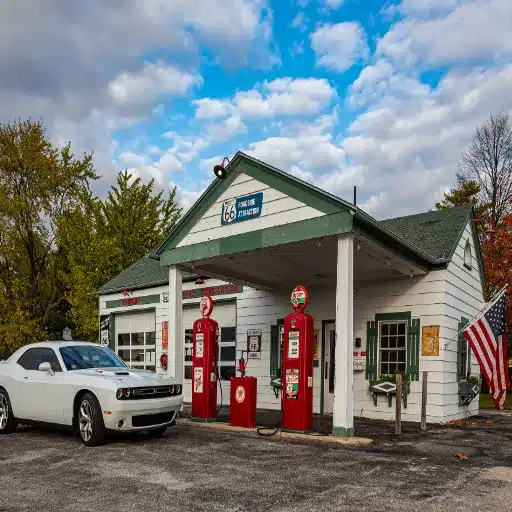
Ambler’s Texaco Gas Station in Dwight, Illinois, is a prominent Route 66 spot for early 20th-century architecture of gas station architecture. Built in 1933, it stands as an example of the better-preserved design and a nostalgic reminder of the golden age of the highway. Visitors can explore the restored features of the station along with various exhibits that reflect on its importance to the iconic American highway.
What to Expect on Your Visit
For a proper American throwback, Ambler’s Texaco Gas Station should certainly be in one’s itinerary. Restored with a flair of vintage, from the Texaco sign to the design details and the gas pumps, everything is maintained with finesse. The interior boasts informative collections about the workings of the station when Route 66 was at its prime, along with some photographs and memorabilia, and anecdotes from travelers who had once depended on the services of the station.
The picturesque environment and historic importance of this site often lure road-trippers, history buffs, and photographers. Hours may vary with occasion and generally feature free entry, making it a good educational spot for all ages. Some events or tours may be anticipated, so best to check beforehand to map out your time here better. Located in Dwight, the site also makes a nice stop among many other attractions along Route 66.
Dining and Shopping Options Nearby
Being close to a historic site, Dwight offers dining and shopping experiences that enhance any visit to it. Great for a filling lunch, the Old Route 66 Family Restaurant is famous among locals and travelers, serving traditional American comfort food in a nostalgic ambience infused with scenic displays of the road’s history. Should you wish to stop by for something fast and casual, Station 343 caters well, offering some tasty pizza and a variety of sandwiches in an inviting atmosphere.
For shopping lovers, the town has many unique shops that showcase local artisans and history. On Main Street, the boutique shops sell everything from antiques and handmade goods to Route 66 souvenirs. Also, the Dwight Harvest Days Farmers Market, held seasonally, is a great location to pick up local fresh products, baked treats, and arts and crafts.
A little indulgence in home cooking, or a stroll and window shopping around town here, completes the Route 66 trip with some memories.
Tips for Travelers on Route 66
Plan Your Route and Stops in Advance
With Route 66 being over 2,400 miles long and running through eight states, planning your trip would give you the maximum experience from the journey. Pick out major landmarks, museums, and attractions, including famous stops such as Cadillac Ranch in Texas, Painted Desert in Arizona, and the Missouri Route 66 State Park. Give utmost attention to your time to spend on each major stop so as to cherish the unique history and charm presented by each.
When is the Best Time to Travel
Route 66 is best traveled in spring (April-June) and fall (September-October) when temperatures are mild and in full glory of the season. Summers can be scorching hot, especially in states like Arizona and New Mexico. So, if traveling during this time, carry plenty of water and sunblock.
Where to Stay and Eat
The motels along Route 66, like the Blue Swallow in New Mexico and the Wagon Wheel in Missouri, are pure roadside charm. Do not miss standing in the line for Lou Mitchell’s in Chicago, nor The Big Texan Steak Ranch in Amarillo, known for its huge appetites and deep association with Route 66 lore. When planning your trip, advise on making early reservations, especially in peak travel season.
Pack Essential Gear for the Journey
Since a few parts of Route 66 pass through some remote areas, it would be useful to carry essentials such as a well-stocked first aid box, plenty of water, munchies, and electronic chargers. A good paper map or Route 66 guidebook will be very useful if you suddenly lose your GPS signal in these rural areas.
Know Local History and Anecdotes
Amid much joy and happiness, traveling Route 66 does connect one with an aura of its historical and cultural significance. Many towns feature a museum or a visitor center bearing artworks to show their connection with the Mother Road. For instance, the Route 66 Museum in Clinton, Oklahoma, and the Arizona Route 66 Museum in Kingman throw quite some light on the interplay of the American way of life along Route 66 and the route itself during the days of the Dust Bowl migration.
Beware of Road Conditions
Solutions have been crafted for various parts of Route 66 that have since been decommissioned or retained for historic value, and maintenance may vary for different segments. Keep your vehicle in fine condition and always check the road conditions before you set out, especially for those older bits of Route 66, which may have uneven pavement or even gravel roads. Parallel to Route 66, one-sided modern highways exist, providing availability for any needs that may arise.
By keeping these few points in mind, travelers will have a gentler and more fulfilling experience when moving along America’s famous Route 66.
The Importance of Preserving History
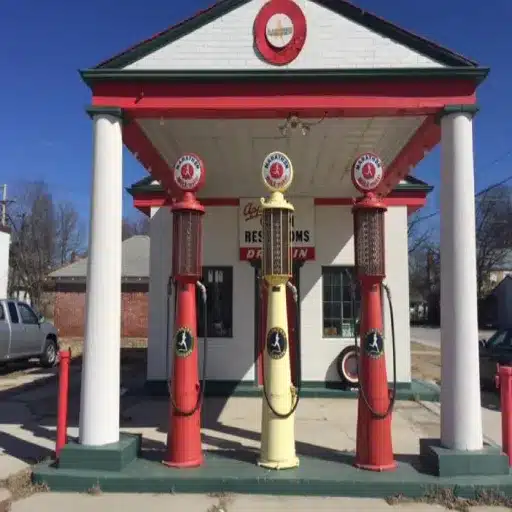
Preserving history is critical for cultural identity and an individual’s connection to the past. It allows future generations to learn from historical experience, celebrate their heritage, and see how society came to be. In their defense, historical sites need to be preserved; artifacts and stories should also be protected lest the valuable history and traditions perish through time. Historical preservation will, however, add to the pride of the community, aid, and promote tourism, all for the good of its people and for the local economy.
The Role of Historic Gas Stations in American Culture
Historic gas stations are more than just functional spaces; they represent key events in the evolution of American infrastructure and culture. As automobile travel ascended in the early 20th century, these gas stations evolved from simply passing places to being the very nodes of community development. They were good reference points for members of the traveling public who needed the services they provided, and the stations were social aggregation points. Most historic gas stations are testimonies to the common architectural styles of their period, ranging from Art Deco all the way to Mid-Century Modern, thereby exhibiting how contemporary design trends permeated everyday structures.
With the American road trip fully celebrated, these service stations stood for freedom, exploration, and the sprawling countryside hiding behind various brand names and unique signage, sometimes even sparking nostalgia today. When preserving these historic sites, we induce today’s society into a period when gas stations were investment fronts for car-centric lifestyles and road networks, offering valuable insight into America’s evolving culture and economy.
Future of Ambler’s Texaco Gas Station
The future of Ambler’s Texaco Gas Station should be marked by its continuous restoration and adaptation as a lively community landmark. It strives to balance its historical essence with repurposing for educational tours, cultural activities, and possibly a small museum or café. If the goal is to keep it watching the past and keeping a little boisterous among its local crowd and travelers, the heritage would certainly live on to be appreciated by future generations.
Encouraging Preservation Efforts
Preserving historic structures such as Ambler’s Texaco Gas Station is essential for preserving cultural heritage and cultivating community pride. According to the leading preservation associations, the efforts should be concentrated on obtaining grant funding, local governmental support, and cooperation with historical societies. Public awareness campaigns, volunteer programs, and events can all serve to rally support for the preservation efforts. Meanwhile, restoration projects can receive further encouragement through incentives like tax credits and collaboration with the local business community. Elevating the historical significance of this station and its potential as an educational and cultural site can bring communities together to ensure the station’s long-term preservation.
Reference Sources
National Register of Historic Places
Frequently Asked Questions (FAQs)
What is Ambler’s Texaco Gas Station?
Ambler’s Texaco Gas Station is a historic filling station located within the village of Dwight, Illinois. Built in 1938, the station underwent a fuel stop operation along Route 66, going on to gain recognition as one of the longest-operating gas stations along this famous highway. The station acted as a name of great renown, fueling all passengers on their way through Illinois.
How Did Ambler’s Texaco Gas Station Become Known as Vernon’s Texaco?
Once Ambler sold the gas station to Earl Vernon, it took the name Vernon’s Texaco. The name change marked an important change in ownership while ensuring it remained an essential stop on Route 66, especially for those traveling along the historic Route 66 corridor in Illinois.
What happened to Ambler’s Texaco Station after the closing?
After functioning as a gas station from 1938 to 1966, Ambler’s Texaco Station fell vacant. Restoration and reopening followed under the aegis of the Route 66 corridor preservation effort. This restoration lets the station keep the aura of historical importance and, secondly, draws tourist interest in Route 66 heritage.
Is Ambler’s Texaco Station a landmark?
Yes, Ambler’s Texaco Station was recorded as a landmark in 2001. Its long-running operation and historical importance gave credence to its landmark status under the National Register of Historic Places. The National Park Service also recognizes the importance of such historic filling stations in preserving the history of the route.
What were the services offered at Ambler’s Texaco Gas Station?
Ambler’s Texaco Gas Station was in operation for sixty-six continuous years as a filling station dispensing fuel. Of course, provided with a trio of Texaco pumps, it catered to the needs of errant travelers on the historic highway. These weary travelers found respite here during their interminable vehicular journeys.
Where is Ambler’s Texaco Gas Station located?
Ambler’s Texaco Gas Station stands on the north side of the present-day intersection of Old U.S. Route 66 with Illinois Route 17 in Dwight. Its location near the famous highway made it a convenient stop for the interlopers who were either malicious or ignorant of the cultural and historical aspects of the highway.
What is the significance of the Route 66 Corridor Preservation Program?
The Route 66 Corridor Preservation Program can be considered very important for the maintenance and restoration of such historic sites as Ambler’s Texaco Gas Station. The Program is set up to conserve and protect the history of the road so that entities like the station might educate future generations on the life of Route 66 and how it affected American road travel.
Who owned and operated Ambler’s Texaco Station?
For many years, Ambler ran the station and dispensed fuel and service for the countless travelers who passed through. After the station was sold, it kept working under new owners but kept its identity as a much-cherished gas station on Route 66.







